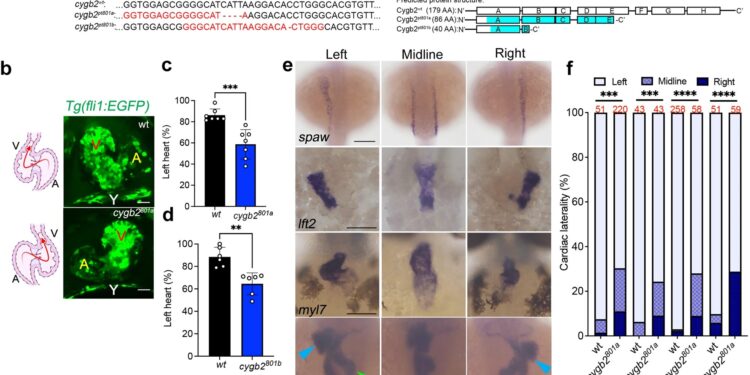In a study led by the University of Maryland School of Medicine, researchers discovered for the first time that a certain type of protein similar to hemoglobin, called cytoglobin, plays an important role in heart development. Specifically, it affects the correct left-right configuration of the heart and other asymmetrical organs.
The results, published today in the journal Natural communicationscould potentially lead to the development of new therapeutic interventions to modify the processes that lead to these defects.
The team used CRISPR gene-editing technologies to knock out the cytoglobin gene in zebrafish. The lack of cytoglobin caused embryos to develop with mirrored hearts, meaning the heart had an inverted left-right configuration. In humans, cytoglobin is involved in the processes of nitric oxide, a compound that helps regulate healthy blood flow to organs.
The study’s co-senior author, Mark T. Gladwin, MD, the John Z. and Akiko K. Bowers Distinguished Professor and dean of the University of Maryland School of Medicine and vice president for medical affairs of the University of Maryland, Baltimore, has studied the effects of nitric oxide on blood vessels for more than 20 years, including the results of this recent study.
“Since its discovery twenty years ago, cytoglobin has been expressed in almost all human tissues, but the mechanisms by which this protein works were largely unknown,” said Dr. Gladwin. “We know that cytoglobin may play a role in modulating and maintaining nitric oxide levels, but our new finding indicates that it positively regulates NO production to ensure proper cilia function, and its absence may lead to major abnormalities of organ laterality.”
To conduct the study, the research team knocked out the cytoglobin gene in zebrafish and were surprised to find that this led to dramatic defects in the structure and location of organs in developing embryos. The heart, for example, was located on the right side of the fish instead of the left, with a loop to the left instead of the right.
“We discovered that cytoglobin plays a critical role in the structure and function of tiny hair-like structures called cilia, which determine asymmetry and proper development of organs,” said Paola Corti, Ph.D., assistant professor of biochemistry, lead author of the study. and molecular biology at UMSOM.
This is the first time that cytoglobin – or one of the globin proteins such as hemoglobin – has been implicated in fetal development and that a deficiency could be linked to birth defects. This is also the first time that cytoglobin has been linked to cilia function. Such a discovery could open the door to developing treatments for rare birth defects that affect eyelash movement.
About 1 in 10,000 to 30,000 people are born with primary ciliary dyskinesia (PCD), a rare condition that affects the eyelashes and can cause breathing problems due to thickened mucus blocking the airways. “Kartagener syndrome is a form of PCD and is known to cause the type of heart defects seen in zebrafish, where the heart is abnormally positioned to the right and rotated,” Dr. Corti said. “There is no cure for this disease, just surgery to repair heart defects and treatments to manage the symptoms.”
While certain genes have been identified as responsible for approximately 70 percent of PCD cases, cytoglobin may play a key role in the 30 percent of cases with no known genetic cause.
“We found the phenotype and connected the dots to the cilia. In the presence of cytoglobin, we were able to track the function of the protein and how it led to proper cilia function and organ development. In the absence, we seen these flaws,” Elizabeth said. Rochon, Ph.D., first author of the study and assistant professor of medicine at UMSOM.
More information:
Elizabeth R. Rochon et al, Cytoglobin regulates cilia motility and NO-dependent organ laterality during development, Natural communications(2023). DOI: 10.1038/s41467-023-43544-0
Provided by University of Maryland School of Medicine
Quote: Researchers discover first-ever link between a hemoglobin-like protein and normal heart development (December 15, 2023) retrieved December 15, 2023 from
This document is subject to copyright. Apart from fair use for private study or research purposes, no part may be reproduced without written permission. The content is provided for information only.



